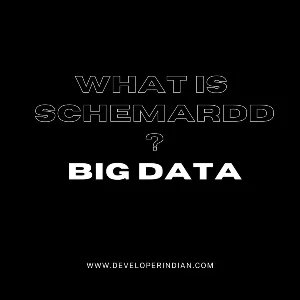what do you understand schemardd ?
#spark #schemardd #schema #spark schemardd , #schemardd in spark

Understanding SchemaRDD in Apache Spark
What is SchemaRDD?
A SchemaRDD is an RDD (Resilient Distributed Dataset) in Apache Spark that has a defined schema, similar to a table in a relational database. It allows structured data processing using SQL queries within Spark. SchemaRDD was introduced in early versions of Spark but has since been replaced by DataFrame API in Spark 1.3. However, the core functionality remains the same.
SchemaRDDs can be registered as tables within the SQLContext, making them queryable using SQL syntax. This provides a powerful way to perform structured data analysis on large-scale datasets in a distributed computing environment.
How to Define a SchemaRDD?
One of the most common ways to define a SchemaRDD is by using case classes in Scala. This approach allows Spark to automatically infer the schema using reflection.
Example: Creating a SchemaRDD in Apache Spark
// Define a case class with schema structure
case class Record(key: Int, value: String)
// Initialize SparkContext and SQLContext
val sc: SparkContext // Existing SparkContext
val sqlContext = new SQLContext(sc)
// Import SQL functions and implicit conversions
import sqlContext._
// Create an RDD with case class instances
val rdd = sc.parallelize((1 to 100).map(i => Record(i, s"val_$i")))
// Register the RDD as a table in SQLContext
rdd.registerAsTable("records")
// Execute SQL query on the registered table
val results: SchemaRDD = sql("SELECT * FROM records")
Benefits of Using SchemaRDD
- Structured Querying: SchemaRDD enables structured querying of data using SQL, making it easier for analysts and engineers to process large datasets.
- Schema Enforcement: It ensures that the dataset follows a predefined schema, reducing errors caused by incorrect data formats.
- Compatibility with SQLContext: SchemaRDDs integrate seamlessly with SQLContext, allowing SQL-based operations on distributed data.
- Performance Optimization: Spark optimizes queries executed on SchemaRDDs using Catalyst Optimizer, improving execution speed and efficiency.
- Interoperability: SchemaRDDs can be easily converted to DataFrames, which are more powerful and support a wide range of transformations.
Transition to DataFrames
SchemaRDD was deprecated in Spark 1.3 and replaced by DataFrames, which offer enhanced capabilities. The modern equivalent of SchemaRDD is:
val df = sqlContext.createDataFrame(rdd)
df.createOrReplaceTempView("records")
val results = sqlContext.sql("SELECT * FROM records")
Conclusion
SchemaRDD in Apache Spark provided a structured way to work with distributed datasets using SQL queries. While it has been replaced by DataFrames, understanding SchemaRDD helps in grasping the fundamentals of Spark SQL and structured data processing. For modern applications, it's recommended to use DataFrames and Spark SQL for enhanced performance and functionality.
Spark SQL allows relational queries expressed in SQL, HiveQL, or Scala to be executed using Spark. At the core of this component is a new type of RDD, SchemaRDD. SchemaRDDs are composed Row objects along with a schema that describes the data types of each column in the row. A SchemaRDD is similar to a table in a traditional relational database. A SchemaRDD can be created from an existing RDD, Parquet file, a JSON dataset, or by running HiveQL against data stored in Apache Hive.